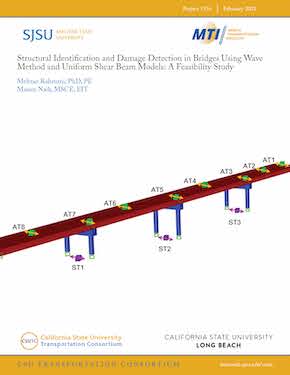- 408-924-7560
- mineta-institute@sjsu.edu
- Donate
Structural Identification and Damage Detection in Bridges using Wave Method and Uniform Shear Beam Models: A Feasibility Study
This report presents a wave method to be used for the structural identification and damage detection of structural components in bridges, e.g., bridge piers. This method has proven to be promising when applied to real structures and large amplitude responses in buildings (e.g., mid-rise and high-rise buildings). This study is the first application of the method to damaged bridge structures. The bridge identification was performed using wave propagation in a simple uniform shear beam model. The method identifies a wave velocity for the structure by fitting an equivalent uniform shear beam model to the impulse response functions of the recorded earthquake response. The structural damage is detected by measuring changes in the identified velocities from one damaging event to another. The method uses the acceleration response recorded in the structure to detect damage. In this study, the acceleration response from a shake-table four-span bridge tested to failure was used.
Pairs of sensors were identified to represent a specific wave passage in the bridge. Wave velocities were identified for several sensor pairs and various shaking intensities are reported; further, actual observed damage in the bridge was compared with the detected reductions in the identified velocities. The results show that the identified shear wave velocities presented a decreasing trend as the shaking intensity was increased, and the average percentage reduction in the velocities was consistent with the overall observed damage in the bridge. However, there was no clear correlation between a specific wave passage and the observed reduction in the velocities. This indicates that the uniform shear beam model was too simple to localize the damage in the bridge. Instead, it provides a proxy for the overall extent of change in the response due to damage.
MEHRAN RAHMANI, PhD, PE (Principal Investigator)
Dr. Mehran Rahmani is an assistant professor in the Civil Engineering Construction Engineering Management (CECEM) department at California State University, Long Beach (CSULB). He earned his PhD in Structural and Earthquake Engineering from the University of Southern California (USC) in 2014, his MS in Electrical Engineering (with an emphasis on signal processing) from USC in 2013, and his MS in Structural Engineering from Sharif University of Technology (Iran) in 2009. Prior to joining CSULB, Dr. Rahmani, a registered Professional Engineer (PE) in the State of California, worked as a Senior Engineer and a Project Engineer in the structural engineering industry from 2014–2017.
Dr. Rahmani’s research focuses on structural system identification, structural health monitoring, and earthquake damage detection of buildings and bridges using sensory data. His PhD research was focused on developing a wave-based methodology for remote post-earthquake structural damage detection that is robust when applied to actual structures and calibrated using data from full-scale buildings. His PhD research was funded by NSF (CMMI-0800399). He has been instrumental in advances in wave-based structural identification and monitoring in the past ten years, receiving more than 300 citations for his technical papers.
MANAN NAIK, MSCE, EIT (Graduate Research Assistant)
Manan Naik joined California State University, Long Beach as a graduate student in Fall 2017. He obtained his MS in Civil Engineering from CSULB in 2020 and his BS in Civil Engineering from Gujarat Technological University (India) in 2017. He is a certified Engineer-in-Training (EIT) in the State of California.
Naik was a graduate research assistant at California State University, Long Beach from 2018–2020. His responsibilities as a graduate student included performing computer modeling and analysis for structural systems for all types of bridges and materials using SAP2000, assisting with writing and running MATLAB programs to analyze sensory data in select bridges, preparing and writing summary reports, and preparing plots and spreadsheets for analysis results.
-
Contact Us
San José State University One Washington Square, San Jose, CA 95192 Phone: 408-924-7560 Email: mineta-institute@sjsu.edu






